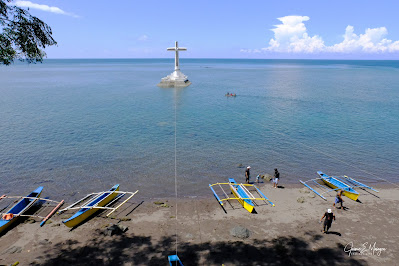Perhaps the most famous and most visited landmark of Camiguin Island is the "sunken cemetery" located in the capital town of Catarman. Actually, it was not just the cemetery that sank, but a substantial portion of the old town of Catarman, which led to the transfer of the town to its present site then known as Bgy. Guiob.
According to its Local Government Unit's web page, "Catarman, as called by the Visayans, means a point or cape. It is the oldest town in Camiguin and was founded in 1622 under the patronage of San Roque having Fray Francisco de la Concepcion, Recollect as its first priest. It had 357 tributes and a population of 1,625 with Sagay and Mambajao as stations or visitas.
'Chronicles has it that the first parish that was established on this island was that of Guinsiliban (1596 or 1599), with station or visitas in Catarman and Sagay.
'Vicente Elio wrote that, Magellan came to discover Camiguin where he set foot in April 1521. Local folks also claim that Magellan stopped over to get water at the site where Catarman was established. For more than two centuries, only the parishes of Guinsiliban and Catarman existed."
Magellan may have come to the island from Butuan, without the argument of whether the navigator and company has celebrated the first mass in the Masao.
On a clear day, the island of Camiguin, with its distinct Mt. Mambajao peak is visible from as far as Cabadbaran City in Agusan del Norte to the East.
 |
Camiguin Island |
In the 1870s, Mt. Vulcan, a volcano near Catarman erupted and caused the cemetery along with the capital city surrounding it to sink below sea level." Subsequent eruptions have caused it to sink further below the sea.
At present, the old part of the town on Google Earth is discernible as a shallow portion along the province's western coastal road. From the observation deck on the shore, the seashore is several meters below, and the cemetery is still deep below the sea.
Nothing is there to see beneath the waves, except for a barnacle-encrusted old concrete cross and a figure of a saint or angel as natives say.
A memorial cross was built to remember those who were long lost in Mt. Vulcan's birth, then both the living and the dead. One may rent a banca to be at the marker, to contemplate, to satisfy curiosity, or have a selfie just to let everyone know that he'd been there.
My first visit was on All Saints Day and on the following All Souls Day. With the cross against the blue waters and the setting sun, one is filled with sadness and attachment to those who perished, though they are unknown nor unrelated to us, we felt the oneness as we have also compatriots who likewise have died in the volcanic upheavals of Mt. Mayon.
The feeling of despondency is brought about by the thought of them who now lay in deep slumber, with nothing but the cool blue waves to "warm and comfort them", sans the green sod, flowers, or tombstones.
"Eternal rest grant unto them, O Lord, and let perpetual light shine upon them. May their souls and the souls of all the faithful departed, through the mercy of God, rest in peace. Amen."
 |
Depth of the cemetery and sinking, from the
main road level to the sea level, and even a few meters
down to the sea bed.
|
























































